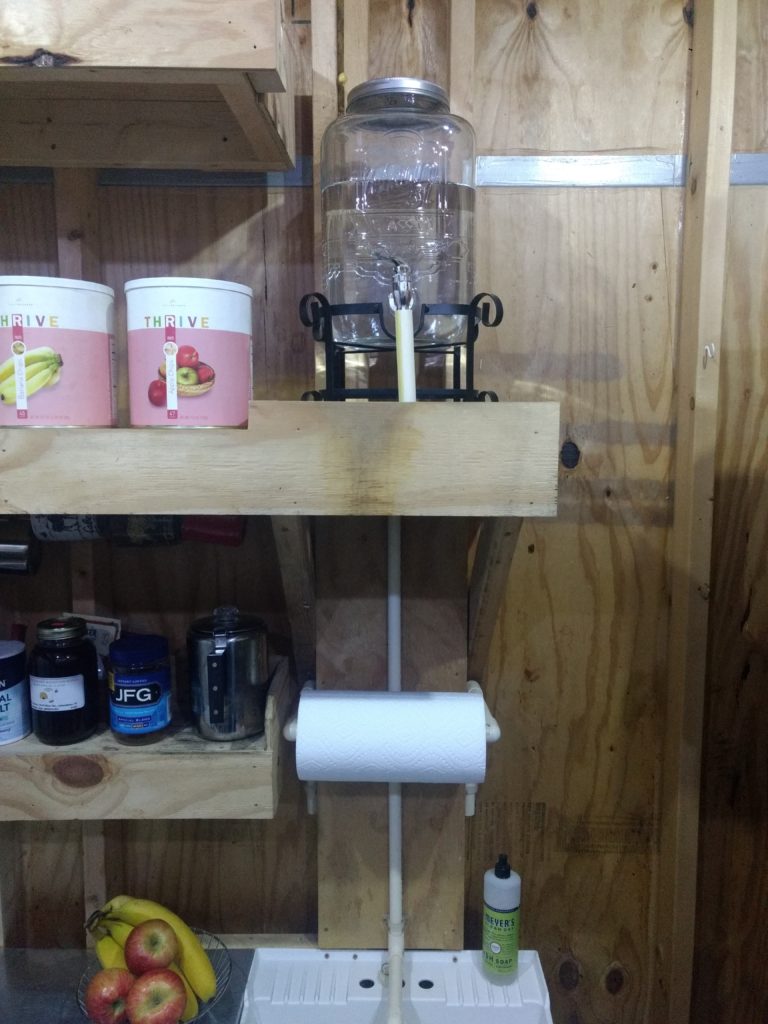One of the first problems that I had to overcome after going off grid was a sink. Washing your hands and brushing your teeth outside gets old! Brushing your teeth isn’t too bad. But it’s hard to wash your hands while you pour water over your hands. Logistically, it’s kind of tough!
It was a no-brainer to use a utility sink and a french drain. The sink is durable and freestanding. No cabinet or brackets needed. The french drain prevents mud, puddling and is simple to make. The hard part was figuring out my water delivery system.

A simple design
After much brainstorming, I decided on a gravity fed system. As with nearly all my cabin projects, three requirements are necessary. Efficiency, effectiveness and simplicity are a must. Efficiency means that it’s easy to install and is durable. Effectiveness means that it has to get the job done. Simplicity means it’s easy to use.
A simple dispenser
After looking around at what was available to meet those needs, I decided on a 3 gallon beverage dispenser. It was obviously safe for drinking water. The large opening in the top meant that it was easy to fill. I knew the lever on the tap would make it easy to use.

I arrived at a height of the dispenser by putting it just over my head height and just within reach of my wife. Although we have to use our bunk ladder to fill it, I don’t hit my head on it! I hit my head enough crawling under houses during my HVAC and electrical career! I used 3/4″ CPVC pipe to deliver the water as it is safe for drinking water and is a good friction fit over the tap.
A simple drain
For the drain, I used a “no-hub rubber coupling” to attach the sink drain outlet to 1 1/2″ PVC pipe. I ran the PVC pipe straight down through the floor and a couple of inches into the french drain. I didn’t install a P-trap as there are no sewer gases.

The french drain was simple. I dug a hole just under the edge of the building. The hole is around 1′ deep and 18″ in diameter. I then filled it with clean gravel. The soil around the drain area is sterile and rocky. Otherwise, I would have lined the hole with landscape fabric to prevent roots and mud from clogging the drain. The gravel dispenses the water throughout the hole. The only time the drain gives any problem is with multiple days of single digit temps.
A durable dispenser
The beverage dispenser we use is glass with a metal lid and a plastic tap. We don’t drink water from it as our water needs filtering before consumption. The dispenser has held up well in the nearly two years we’ve used it. We’ve literally used it thousands of times! That’s a lot of hands and dishes!

One word of caution, the metal lids on dispensers I found were not stainless steel or aluminum. These dispensers are not designed for continual use. Therefore, the inside of the lids will rust with continual use. We use part of a freezer “zip style” storage bag over the dispenser fill opening. This prevents moisture from rusting the inside of the lid and it is rigid enough to not sag into the water when the dispenser is full. There are dispensers available with glass lids, but due to its elevation and frequency of use, we chose a metal lid.
This overall design works for us. It fits our needs for washing hands and dishes. Yes, the water isn’t heated. Sure, the pressure is at a minimum. However, the system gets the job done. And yes, it is efficient, effective and simple!
Ambitious Feller
“If the women don’t find you handsome, they should at least find you handy!” Red Green
(This post contains affiliate links, please see site policies)
Related Products




